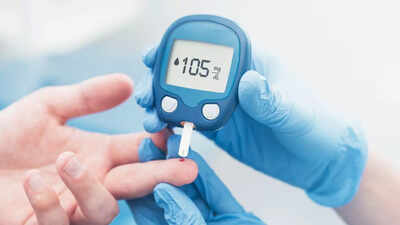For individuals managing diabetes, maintaining stable blood sugar levels is a continuous effort. A frequent challenge is experiencing elevated blood glucose levels upon waking, a situation that can be both perplexing and concerning. This occurrence is commonly attributed to the "Dawn Phenomenon," a natural increase in blood glucose during the early morning hours.

Image: An illustrative depiction of blood sugar monitoring.
Accurate measurement of morning glucose is crucial for developing effective management strategies, including adjustments to medication, diet, and lifestyle. By understanding your body's individual patterns and responses, you can implement strategies to address high blood sugar levels. This may involve modifying your medication regimen, dietary habits, or exercise routine. Taking a proactive approach to managing your diabetes allows you to achieve optimal blood sugar control and improve your overall health.
Blood sugar, also known as blood glucose, refers to the amount of glucose (sugar) present in the blood. Glucose is a simple sugar that serves as the body's primary energy source. Blood sugar levels naturally rise in the early morning hours due to the release of hormones such as cortisol and growth hormone. This natural increase in blood sugar is known as the "Dawn Phenomenon."
The dawn phenomenon is characterized by an increase in blood sugar (glucose) levels during the early morning, typically between 4 AM and 8 AM. It is a common occurrence in individuals with diabetes, affecting over 50% of those with Type 1 or Type 2 diabetes.
Monitoring blood sugar levels, especially in the morning, is essential for guiding personalized management plans and enabling adjustments to:
According to the American Diabetes Association, the primary cause of elevated morning blood sugar is decreased insulin activity. Between 3 AM and 8 AM, the body releases hormones like cortisol and growth hormone, which stimulate the liver to increase glucose production, providing energy for waking up.
However, in individuals with diabetes:
Consequently, blood sugar levels increase, leading to high morning blood sugar.
The primary indicator of the dawn phenomenon is elevated blood sugar levels in the morning, often detected through glucometer readings or continuous glucose monitoring devices (CGM).
Common symptoms of significantly elevated blood sugar levels may include:
The most effective method for detecting the dawn phenomenon is through continuous glucose monitoring (CGM), which tracks glucose levels 24/7. A CGM device measures glucose levels every few minutes and generates a graph illustrating blood sugar patterns over time. If CGM is unavailable, healthcare providers can still suspect the dawn phenomenon by analyzing consistent patterns of glucometer readings. This provides a comprehensive view of glucose fluctuations, helping to:
If left unmanaged, the dawn phenomenon can lead to consistently high blood sugar levels, increasing the risk of diabetes complications, including:
Failure to address the dawn phenomenon can result in prolonged periods of high blood sugar, ultimately affecting long-term health outcomes.
Certain lifestyle changes and home remedies may help lower morning blood sugar levels:
If experiencing high blood glucose levels frequently (more than three times in 2 weeks), consulting a doctor is recommended. Before trying home remedies or altering medication, individuals with diabetes should seek personalized advice from their doctor.
The timing of blood sugar tests is crucial, as blood sugar levels fluctuate after consuming carbohydrates. Recommended times for testing include:
To manage blood sugar spikes associated with the dawn phenomenon, individuals with diabetes can try the following strategies:
If elevated morning blood sugar levels persist, consulting a doctor is necessary to receive individualized advice. Consistency with your routine and regular follow-ups with your healthcare provider can significantly reduce the risk of complications related to the dawn phenomenon.
Older articles
 UNESCO's World Heritage Wonders: Unveiling 10 Iconic Sites, From Petra to the Pyramids
UNESCO's World Heritage Wonders: Unveiling 10 Iconic Sites, From Petra to the Pyramids
 JPG to PDF: A Comprehensive Guide for Graphic Designers & Professionals
JPG to PDF: A Comprehensive Guide for Graphic Designers & Professionals
 England's Bold Claim: Could They Have Chased Down 450 Against India?
England's Bold Claim: Could They Have Chased Down 450 Against India?
 iQoo Z9 Turbo: Rumored Specs Emerge – Snapdragon 8s Gen 3, 6000mAh Battery Highlighted
iQoo Z9 Turbo: Rumored Specs Emerge – Snapdragon 8s Gen 3, 6000mAh Battery Highlighted
 5 Often-Missed Warning Signs of Bladder Cancer You Need to Know
5 Often-Missed Warning Signs of Bladder Cancer You Need to Know
 Shadman Islam Defends Bangladesh Batters After Day 1 Struggles Against Sri Lanka
Shadman Islam Defends Bangladesh Batters After Day 1 Struggles Against Sri Lanka
 Tick Bite Paralyzes Fitness Influencer: A Wake-Up Call for Outdoor Enthusiasts
Tick Bite Paralyzes Fitness Influencer: A Wake-Up Call for Outdoor Enthusiasts
 Freestyle Chess Grand Slam Loses India Leg: Sponsorship Issues Sideline Magnus Carlsen
Freestyle Chess Grand Slam Loses India Leg: Sponsorship Issues Sideline Magnus Carlsen
 KL Rahul Puts Country First, Prioritizes England Tests Over Newborn Child
KL Rahul Puts Country First, Prioritizes England Tests Over Newborn Child
 Samsung Galaxy A55 vs. Vivo V30 Pro: Flagship Features Clash in Mid-Range Android Battle
Samsung Galaxy A55 vs. Vivo V30 Pro: Flagship Features Clash in Mid-Range Android Battle